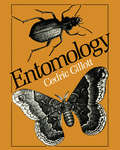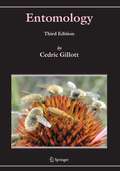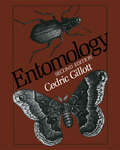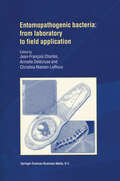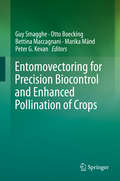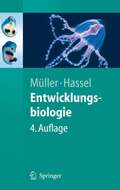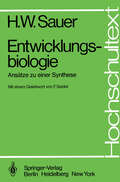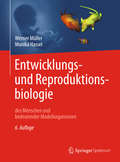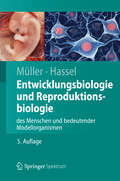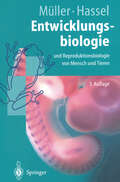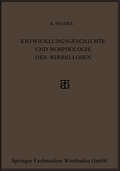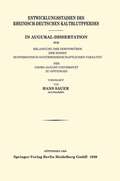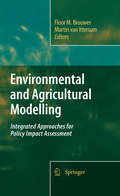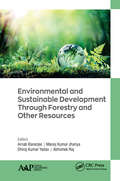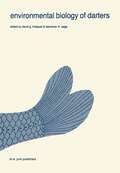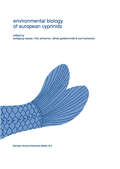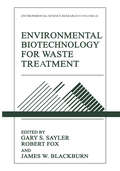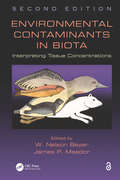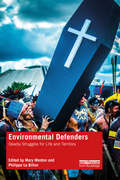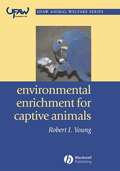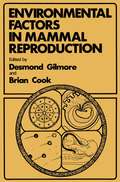- Table View
- List View
Entomology
by Cedric GillottThe idea of writing this book was conceived when, in the late 1960s, I began teaching a senior undergraduate class in general entomology. I soon realized that there was no suitable text for the class I intended to give. The so-called "general" or "introductory" texts reflected the traditional taxonomic approach to entomology and contained relatively little information on the physiology and ecology of insects. This does not mean that there were no books containing such information. There were several, but these were so specialized and de tailed that their use in an introductory class was limited. I hold a strong belief that an undergraduate general entomology course should provide a balanced treatment of the subject. Thus, although some time should be devoted to taxonomy, including identification (best done in the laboratory, using primar ily material which students themselves have collected, supplemented with specimens from the general collection), appropriate time should be given also to discussion of the evolution, development, physiology, and ecology of in sects. In the latter category I include the interactions between insects and Man because it is important to stress that these interactions follow normal ecological principles. Naturally, the format of this book reflects this belief. The book has been arranged in four sections, each of which necessarily overlaps with the others.
Entomology
by Cedric GillottGillott’s thorough yet clear writing style continues to keep Entomology near the top of the class as a text for senior undergraduates, and for graduate students and professionals seeking an introduction to specific entomological topics. The author’s long-held belief that an introductory entomology course should present a balanced treatment of the subject is reflected in the continued arrangement of the book in four sections: Evolution and Diversity, Anatomy and Physiology, Reproduction and Development, and Ecology. For the third edition, all chapters have been updated. This includes not only the addition of new information and concepts but also the reduction or exclusion of material no longer considered "mainstream", so as to keep the book at a reasonable size. Based on exciting discoveries made during the previous decade, the topics of insect evolutionary relationships, semiochemicals, gas exchange, immune responses (including those of parasites and parasitoids), flight, and the management of pests have received particular attention in the preparation of the third edition. Overall, more than 30 new or significantly revised figures have been incorporated.
Entomology
by Cedric GillottExtensively revised, the Second Edition continues to offer senior undergraduate students a well-balanced treatment of all major areas in entomology. This edition features coverage of the new phylogenies for most of the insect orders
Entomopathogenic Bacteria: from Laboratory to Field Application
by J. F. Charles Armelle Delécluse C. Nielsen-Le RouxEntomopathogenic bacteria (Bacillus thuringiensis and B. sphaericus) are increasingly used as biopesticides to control larval insect populations which are either agricultural or forestry pests and to reduce those which as adults are vectors of severe human diseases. This new book, the first since 1993 to address all aspects of entomopathogenic bacteria, provides undergraduate and graduate students as well as research scientists with a complete, modern view of this important group of bacteria. The authors, chosen for their sustained contributions to the field, cover both fundamental and applied research in this area. The main topics include bacterial ecology and taxonomy, toxin diversity, activity and mode of action, regulation and environment of the genes, safety and ecotoxicology, production and field application of the bacteria, and outbreaks of resistant populations. The book concludes with the most recent data obtained on transgenic biotechnology and addresses environmental impact issues.
Entomovectoring for Precision Biocontrol and Enhanced Pollination of Crops
by Guy Smagghe Otto Boecking Bettina Maccagnani Marika Mänd Peter G. KevanThis book focuses on entomovectoring, also known as apivectoring, the method used for managing pollinators to increase crop yields and employ strategies of biocontrol in greenhouses and open fields. It is written by experts working in academia and industry from the different continents of the world. Over the past 25 years Research and Development has successfully investigated the potential of pollinators to perform two tasks: dispersal of biological control agents (BCOs) and their pollination service. This book provides a basic overview of the current literature on the different aspects and factors of this novel technology. It explains and presents practical cases of enhancing pollination coupled with the suppression of plant pathogens and pests under various agricultural production practices from greenhouse to open field conditions and crops ranging from orchard fruits, to small and tender berries, vegetables and oil seeds
Entwicklungsbiologie: und Reproduktionsbiologie von Mensch und Tieren (Springer-Lehrbuch)
by Werner A. Müller Monika HasselDas Lehrbuch bietet einen Überblick über die Entwicklung der bedeutendsten Modellorganismen und die Embryonalentwicklung des Menschen. Im Vordergrund stehen allgemeine Prinzipien und Grundmuster. Hinzu kommen vergleichende Ausführungen zu Aspekten der Evolution, Entwicklungsgenetik und Sexualentwicklung. Daneben werden aktuelle Forschungsfragen behandelt, u. a. zum Evolution Development und dem Einfluss von Umweltsubstanzen auf die Sexualentwicklung. Die 4. Auflage enthält eine Reihe neuer Abbildungen sowie Tafeln mit vierfarbigen Darstellungen.
Entwicklungsbiologie und Reproduktionsbiologie des Menschen und bedeutender Modellorganismen (Springer-Lehrbuch)
by Werner A. Müller Monika HasselDie faszinierende Entwicklung von Ei und Spermium zum komplexen Organismus ist das Thema des Lehrbuchs. Die Autoren liefern einen Überblick über die Entwicklung wichtiger Modellorganismen und die Embryonalentwicklung des Menschen. Dabei berücksichtigen sie aktuelle Forschungsfragen wie u. a. Klonen, transgene Tiere und Gentherapie. In der 5. Auflage sind alle Abbildungen 4-farbig, die Themen „Entwicklung des Menschen“ und „Evolution von Entwicklungsprozessen“ werden ausführlicher dargestellt. Mit umfangreichem Glossar und Literaturverzeichnis.
Entwicklungsbiologie und Reproduktionsbiologie des Menschen und bedeutender Modellorganismen (Springer-Lehrbuch)
by Werner A. Müller Monika HasselDie faszinierende Entwicklung von Ei und Spermium zum komplexen Organismus ist das Thema des Lehrbuchs. Die Autoren liefern einen Überblick über die Entwicklung wichtiger Modellorganismen und die Embryonalentwicklung des Menschen. Dabei berücksichtigen sie aktuelle Forschungsfragen wie u. a. Klonen, transgene Tiere und Gentherapie. In der 5. Auflage sind alle Abbildungen 4-farbig, die Themen „Entwicklung des Menschen“ und „Evolution von Entwicklungsprozessen“ werden ausführlicher dargestellt. Mit umfangreichem Glossar und Literaturverzeichnis.
Entwicklungsbiologie und Reproduktionsbiologie von Mensch und Tieren: Ein einführendes Lehrbuch (Springer-Lehrbuch)
by Werner A. Müller Monika HasselKlonen von Tieren und Menschen ist derzeit das am häufigsten genannte und am heftigsten umstrittene Thema der Entwicklungsbiologie, über das Tagespresse und Medien berichten. Ein anderes Thema ist die Erzeugung "transgener" Tiere, in die artfremde, darunter gar menschliche Gene einge baut werden, und möglicherweise gehört zu diesen Themen auch bald die gezielte Steuerung des Geschlechts. Eng mit der Entwicklungsbiologie ver woben sind aber auch die Krebsforschung und die Gentherapie von Erb krankheiten. Diese beispielhaft herausgegriffenen Themen zeigen schon: Entwicklungsbiologie ist ein hochaktuelles Gebiet der Biologie und auch für die Medizin von Belang. Die Entwicklungsbiologie zählt in der Tat zu jenen Sparten der Biowis senschaften, die derzeit eine explosive Entfaltung erfahren. Treibende Kraft ist das Bestreben der Genetiker und Molekularbiologen, das Wirken von Genen zu verstehen und Verfahren zu finden, um selbst Genaktivitäten steuern zu können. Treibende Kraft ist auch das Bestreben der Mediziner, helfend in das Reproduktionsgeschehen einzugreifen und Fehlleistungen wie die Entwicklung von Krebs zu verstehen. Größte treibende Kraft ist je doch die Wissbegierde des Menschen, der eines der größten Geheimnisse der Natur enträtseln möchte: die Entwicklung eines komplexen Organis mus mit seiner erstaunlichen körperlichen und geistigen Leistungsfähigkeit aus der vergleichsweise wenig strukturierten Materie einer befruchteten Ei zelle.
Entwicklungsgeschichte und Morphologie der Wirbellosen
by Karl HeiderDieser Buchtitel ist Teil des Digitalisierungsprojekts Springer Book Archives mit Publikationen, die seit den Anfängen des Verlags von 1842 erschienen sind. Der Verlag stellt mit diesem Archiv Quellen für die historische wie auch die disziplingeschichtliche Forschung zur Verfügung, die jeweils im historischen Kontext betrachtet werden müssen. Dieser Titel erschien in der Zeit vor 1945 und wird daher in seiner zeittypischen politisch-ideologischen Ausrichtung vom Verlag nicht beworben.
Entwicklungsstadien des Rheinisch-Deutschen Kaltblutpferdes: In Augural-Dissertation zur Erlangung der Doktowürde der Hohen Mathematisch-Naturwissenschaftlichen Fakultät der Georg-August-Universität zu Göttingen
by Hans SauerDieser Buchtitel ist Teil des Digitalisierungsprojekts Springer Book Archives mit Publikationen, die seit den Anfängen des Verlags von 1842 erschienen sind. Der Verlag stellt mit diesem Archiv Quellen für die historische wie auch die disziplingeschichtliche Forschung zur Verfügung, die jeweils im historischen Kontext betrachtet werden müssen. Dieser Titel erschien in der Zeit vor 1945 und wird daher in seiner zeittypischen politisch-ideologischen Ausrichtung vom Verlag nicht beworben.
Environmental and Agricultural Modelling: Integrated Approaches for Policy Impact Assessment
by Floor M. Brouwer Martin IttersumAgriculture increasingly faces the challenge of balancing its multiple functions in a sustainable way. Integrated assessment and modelling (IAM) can provide insight into the potential impacts of policy changes. However, concepts to address the wide range of issues and functions typical for agriculture are still scarce. Environmental and Agricultural Modelling reviews and presents our current understanding of integrated and working tools to assess and compute, ex-ante, alternative agricultural and environmental policy options, allowing: 1. Analysis at the full range of scales (farm to European Union and global) whilst focusing on the most important issues emerging at each scale; 2. Analysis of the environmental, economic and social contributions of agricultural systems towards sustainable rural development and rural viability; 3. Analysis of a broad range of issues and agents of change, such as climate change, environmental policies, rural development options, effects of an enlarging EU, international competition, and effects on developing countries.
Environmental and Sustainable Development Through Forestry and Other Resources
by Arnab Banerjee Manoj Kumar Jhariya Dhiraj Kumar Yadav Abhishek RajThis book looks at using forestry and several other innovative measures to facilitate environmental sustainability, covering an important selection of research that focuses on scientific applications and trends. Chapters discuss such diverse topics as using agroforestry for resource management, employing legumes in agroforestry, livestock management for climate change mitigation, introducing higher plants for air pollution mitigation in urban industrial areas, the uses and benefits of sludge, technological assessment of sewage treatment plants, and much more. This book will be a helpful and informative reference for those in the disciplines of forestry, agriculture, ecology, and environmental science and will also be a pathway to addressing new concepts for a sustainable world.
Environmental and Sustainable Development Through Forestry and Other Resources
by Arnab Banerjee Manoj Kumar Jhariya Dhiraj Kumar Yadav Abhishek RajThis book looks at using forestry and several other innovative measures to facilitate environmental sustainability, covering an important selection of research that focuses on scientific applications and trends. Chapters discuss such diverse topics as using agroforestry for resource management, employing legumes in agroforestry, livestock management for climate change mitigation, introducing higher plants for air pollution mitigation in urban industrial areas, the uses and benefits of sludge, technological assessment of sewage treatment plants, and much more. This book will be a helpful and informative reference for those in the disciplines of forestry, agriculture, ecology, and environmental science and will also be a pathway to addressing new concepts for a sustainable world.
Environmental biology of darters: Papers from a symposium on the comparative behavior, ecology, and life histories of darters (Etheostomatini), held during the 62nd annual meeting of the American Society of Ichthyologists and Herpetologists at DeKalb, Illinois, U.S.A., June 14–15, 1982 (Developments in Environmental Biology of Fishes #4)
by David G. Lindquist Lawrence M. PageThe The following following set set of of papers papers is is mainly mainly a a representa representa have have been been overdue overdue since since the the pioneering pioneering work work of of tive tive sample sample from from 19 19 presentations presentations at at a a special special sym sym Howard Howard Winn Winn in in the the late late 1950's. 1950's. Darters Darters are are rela rela posium posium on on the the comparative comparative behavior, behavior, ecology, ecology, and and tively tively sedentary sedentary and and can can be be easily easily observed observed and and life life histories histories of of darters darters held held during during the the 62nd 62nd (14-15 (14-15 experimentally experimentally manipulated manipulated in in their their natural natural hab- . . June, June, 1982) 1982) annual annual meeting meeting of of the the American American So So itats. itats. They They can can be be transported transported alive alive with with relative relative ciety ciety of of Ichthyologists Ichthyologists and and Herpetologists Herpetologists on on the the ease, ease, and and readily readily acclimate acclimate to to controlled controlled conditions conditions campus campus of of Northern Northern Illinois Illinois University, University, DeKalb, DeKalb, of of the the laboratory laboratory aquarium. aquarium. The The male male nuptial nuptial color color Illinois, Illinois, U. S. A. U. S. A.
Environmental biology of European cyprinids: Papers from the workshop on ‘The Environmental Biology of Cyprinids’ held at the University of Salzburg, Austria, in September 1989 (Developments in Environmental Biology of Fishes #13)
by W. Wieser F. Schiemer A. Goldschmidt K. KotrschalEnvironmental Biotechnology for Waste Treatment (Environmental Science Research #41)
by Gary S. Sayler Robert Fox James BlackburnThe use of biotechnical processes in control of environmental pollution and in haz ardous waste treatment is viewed as an advantageous alternative or adduct to phys ical chemical treatment technologies. Yet, the development and implementation of both conventional and advanced biotechnologies in predictable and efficacious field applications suffer from numerous technical, regulatory, and societal uncertainties. With the application of modern molecular biology and genetic engineering, there is clear potential for biotechnical developments that will lead to breakthroughs in controlled and optimized hazardous waste treatment for in situ and unit process use. There is, however, great concern that the development of these technologies may be needlessly hindered in their applications and that the fundamental research base may not be able to sustain continued technology development. Some of these issues have been discussed in a fragmented fashion within the research and development community. A basic research agenda has been established to promote a sustainable cross-disciplinary technology base. This agenda includes developing new and improved strains for biodegradation, improving bioanalytical methods to measure strain and biodegradation performance, and providing an in tegrated environmental and reactor systems analysis approach for process control and optimization.
Environmental Contaminants in Biota: Interpreting Tissue Concentrations, Second Edition
by W. Nelson BeyDiscussing the interpretation of tissue concentrations of contaminants in wildlife, this updated edition of a bestseller draws on current scientific research and includes new chapters and greater emphasis on aquatic organisms. Each chapter provides a summary and review of a specific chemical along with direction on research methods and the interpretation of conflicting or insufficient data. Chapters include a comprehensive history of contaminant interpretation in wildlife and fish, the use of tissue residues in ecological risk assessment, and detailed coverage of all bioaccumulative contaminants and their physiologic affects.
Environmental Contaminants in Biota: Interpreting Tissue Concentrations, Second Edition
by W. Nelson Beyer James P. MeadorExamining tissue residues of contaminants in biota reveals the movement of contaminants within organisms and through food chains as well as the context for understanding and quantifying injuries to organisms and their communities. Yet tissue concentrations of some contaminants are especially challenging to interpret and the ability of today's analy
Environmental Defenders: Deadly Struggles for Life and Territory (Routledge Explorations in Environmental Studies)
by Mary Menton; Philippe Le BillonThis book is about environmental defenders and the violence they face while seeking to protect their land and the environment. Between 2002 and 2019, at least two thousand people were killed in 57 countries for defending their lands and the environment. Recent policy initiatives and media coverage have provided much needed attention to the protection and support of defenders, but there has so far been little scholarly work. This edited volume explains who these defenders are, what threats they face, and what can be done to help support and protect them. Delving deep into the complex relations between and within communities, corporations, and government authorities, the book highlights the diversity of defenders, the collective character of their struggles, the many drivers and forms of violence they are facing, as well as the importance of emotions and gendered dimensions in protests and repression. Drawing on global case studies, it examines the violence taking place around different types of development projects, including fossil fuels, agro-industrial, renewable energy, and infrastructure. The volume also examines the violence surrounding conservation projects, including through militarized wildlife protection and surveillance technologies. The book concludes with a reflection on the perspectives of defenders about the best ways to support and protect them. It contrasts these with the lagging efforts of an international community often promoting economic growth over the lives of defenders. This volume is essential reading for all interested in understanding the challenges faced by environmental defenders and how to help and support them. It will also appeal to students, scholars and practitioners involved in environmental protection, environmental activism, human rights, social movements and development studies.
Environmental Defenders: Deadly Struggles for Life and Territory (Routledge Explorations in Environmental Studies)
by Mary Menton Philippe Le BillonThis book is about environmental defenders and the violence they face while seeking to protect their land and the environment. Between 2002 and 2019, at least two thousand people were killed in 57 countries for defending their lands and the environment. Recent policy initiatives and media coverage have provided much needed attention to the protection and support of defenders, but there has so far been little scholarly work. This edited volume explains who these defenders are, what threats they face, and what can be done to help support and protect them. Delving deep into the complex relations between and within communities, corporations, and government authorities, the book highlights the diversity of defenders, the collective character of their struggles, the many drivers and forms of violence they are facing, as well as the importance of emotions and gendered dimensions in protests and repression. Drawing on global case studies, it examines the violence taking place around different types of development projects, including fossil fuels, agro-industrial, renewable energy, and infrastructure. The volume also examines the violence surrounding conservation projects, including through militarized wildlife protection and surveillance technologies. The book concludes with a reflection on the perspectives of defenders about the best ways to support and protect them. It contrasts these with the lagging efforts of an international community often promoting economic growth over the lives of defenders. This volume is essential reading for all interested in understanding the challenges faced by environmental defenders and how to help and support them. It will also appeal to students, scholars and practitioners involved in environmental protection, environmental activism, human rights, social movements and development studies.
Environmental Enrichment for Captive Animals (UFAW Animal Welfare #1)
by Robert J. YoungEnvironmental enrichment is a simple and effective means of improving animal welfare in any species – companion, farm, laboratory and zoo. For many years, it has been a popular area of research, and has attracted the attention and concerns of animal keepers and carers, animal industry professionals, academics, students and pet owners all over the world. This book is the first to integrate scientific knowledge and principles to show how environmental enrichment can be used on different types of animal. Filling a major gap, it considers the history of animal keeping, legal issues and ethics, right through to a detailed exploration of whether environmental enrichment actually works, the methods involved, and how to design and manage programmes. The first book in a major new animal welfare series Draws together a large amount of research on different animals Provides detailed examples and case studies An invaluable reference tool for all those who work with or study animals in captivity This book is part of the UFAW/Wiley-Blackwell Animal Welfare Book Series. This major series of books produced in collaboration between UFAW (The Universities Federation for Animal Welfare), and Wiley-Blackwell provides an authoritative source of information on worldwide developments, current thinking and best practice in the field of animal welfare science and technology. For details of all of the titles in the series see www.wiley.com/go/ufaw.
Environmental Enrichment for Captive Animals
by Robert J. YoungEnvironmental enrichment is a simple and effective means of improving animal welfare in any species – companion, farm, laboratory and zoo. For many years, it has been a popular area of research, and has attracted the attention and concerns of animal keepers and carers, animal industry professionals, academics, students and pet owners all over the world. This book is the first to integrate scientific knowledge and principles to show how environmental enrichment can be used on different types of animal. Filling a major gap, it considers the history of animal keeping, legal issues and ethics, right through to a detailed exploration of whether environmental enrichment actually works, the methods involved, and how to design and manage programmes. The first book in a major new animal welfare series Draws together a large amount of research on different animals Provides detailed examples and case studies An invaluable reference tool for all those who work with or study animals in captivity This book is part of the UFAW/Wiley-Blackwell Animal Welfare Book Series. This major series of books produced in collaboration between UFAW (The Universities Federation for Animal Welfare), and Wiley-Blackwell provides an authoritative source of information on worldwide developments, current thinking and best practice in the field of animal welfare science and technology. For details of all of the titles in the series see www.wiley.com/go/ufaw.
